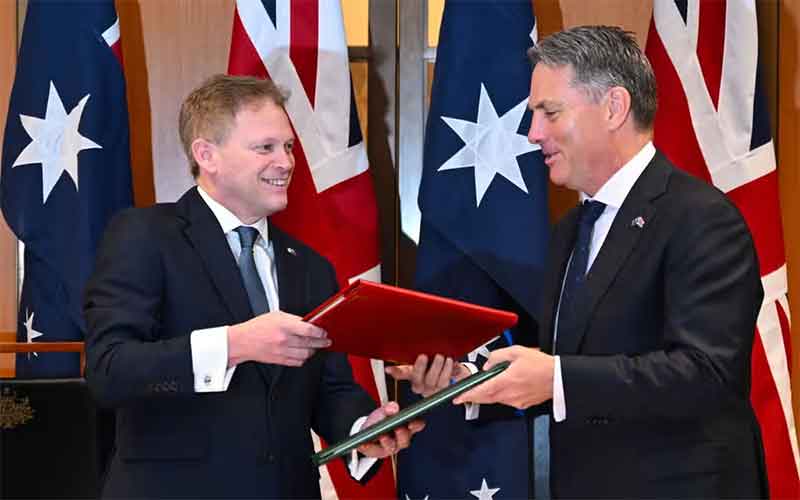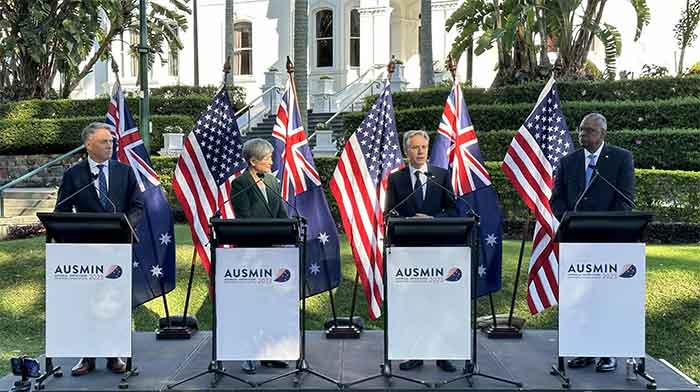
AUKUS, the trilateral pact between the United States, the United Kingdom, and Australia, was a steal for all except one of the partners. Australia, given the illusion of protection even as its aggressive stance (acquiring nuclear-powered submarines, becoming a forward base for the US military) aggravated other countries; the feeling of superiority, even as it was surrendering itself to a foreign power as never before, was the loser in the bargain.
Last month, Australians woke up to the sad reminder that their government’s capitulation to Washington has been so total as to render any further talk about independence an embarrassment. Their Defence Minister, Richard Marles, along with his deputy, the Minister for Defence Industry Pat Conroy, preferred a different story. Canberra had gotten what it wanted: approval by the US Congress through its 2024 National Defense Authorization Act (NDAA) authorising the transfer of three Virginia class nuclear-powered submarines to the Royal Australian Navy, with one off the production line, and two in-service boats. Australia may also seek congressional approval for two further Virginia class boats.
The measures also authorised Australian contractors to train in US shipyards to aid the development of Australia’s own non-existent nuclear-submarine base, and exemptions from US export control licensing requirements permitting the “transfer of controlled goods and technology between Australia, the United Kingdom, and the United States without the need for an export license.”
For the simpleminded Marles, Congress had “provided unprecedented support to Australia in passing the National Defense Authorization Act which will see the transfer of submarines and streamlined export control provisions, symbolising the strength of our Alliance, and our shared commitment to the AUKUS partnership.”
Either through ignorance or wilful blindness, the Australian defence minister chose to avoid elaborating on the less impressive aspects of the authorising statute. The exemption under the US export licensing requirements, for instance, vests Washington with control and authority over Australian goods and technology while controlling the sharing of any US equivalent with Australia. The exemption is nothing less than appropriation, even as it preserves the role of Washington as the drip feeder of nuclear technology.
An individual with more than a passing acquaintance with this is Bill Greenwalt, one of the drafters of the US export control regime. As he told the Australian Broadcasting Corporation last November, “After years of US State Department prodding, it appears that Australia signed up to the principles and specifics of the failed US export control system.” In cooperating with the US on this point, Australia would “surrender any sovereign capability it develops to the United States control and bureaucracy.”
The gem in this whole venture, at least from the perspective of the US military industrial complex, is the roping in of the Australian taxpayer as funder of its own nuclear weapons program. Whatever its non-proliferation credentials, Canberra finds itself a funder of the US naval arm in an exercise of modernised nuclear proliferation. Even the Marles-Conroy media release admits that the NDAA helped “establish a mechanism for the US to accept funds from Australia to lift the capacity of the submarine industrial base.” Airily, the release goes on to mention that this “investment” (would “gift” not be a better word?) to the US Navy would also “complement Australia’s significant investment in our domestic submarine industrial base.”
A few days after the farcical spectacle of surrender by Australian officials, the Congressional Research Service provided another one of its invaluable reports that shed further light on Australia’s contribution to the US nuclear submarine program. Australian media outlets, as is their form on covering AUKUS, remained silent about it. One forum, Michael West Media, showed that its contributors – Rex Patrick and Philip Dorling – were wide awake.
The report is specific to the Navy Columbia (SSBN-826) Class Ballistic Missile Submarine Program, one that involves designing and building 12 new SSBNs to replace the current, aging fleet of 14 Ohio-class SSBNs. The cost of the program, in terms of 2024 budget submission estimates for the 2024 financial year, is US$112.7 billion. As is customary in these reports, the risks are neatly summarised. They include the usual delays in designing and building the lead boat, thereby threatening readiness for timely deployment; burgeoning costs; the risks posed by funding the Columbia-class program to other Navy programs; and “potential industrial-base challenges of building both Columbia-class boats and Virginia-class attack submarines (SSNs) at the same time.”
Australian funding becomes important in the last concern. Because of AUKUS, the US Navy “has testified” that it would require, not only an increase in the production rate of the Virginia-class to 2.33 boats per year, but “a combined Columbia-plus-Virginia procurement rate” of 1+2.33. Australian mandarins and lawmakers, accomplished in their ignorance, have mentioned little about this addition. But US lawmakers and military planners are more than aware that this increased procurement rate “will require investing several billion dollars for capital plant expansion and improvements and workforce development at both the two submarine-construction shipyards (GD/EB [General Dynamics’ Electric boat in Groton, Connecticut] and HII/NSS [Huntington Ingalls Industries’ Newport News Shipbuilding]) and submarine supplier firms.”
The report acknowledges that funding towards the 1+2.33 goal is being drawn from a number of allocations over a few financial years, but expressly mentions Australian funding “under the AUKUS proposed Pillar 1 pathway,” which entails the transfer component of nuclear-powered submarines to Canberra.
The report helpfully reproduces the October 25, 2023 testimony from the Navy before the Seapower and Projection Forces Subcommittee of the House of Armed Services Committee. Officials are positively salivating at the prospect of nourishing the domestic industrial base through, for instance “joining with an Australian company to mature and scale metallic additive manufacturing across the SIB [Submarine Industrial Base].” The testimony goes on to note that, “Australia’s investment into the US SIB builds upon on-going efforts to improve industrial base capability and capacity, create jobs, and utilize new technologies,” and was a “necessary” contribution to “augment VACL [Virginia Class] production from 2.0 to 2.33 submarines per year to support both US Navy and AUKUS requirements.”
The implications from the perspective of the Australian taxpayer are significant. Patrick and Dorling state one of them: that “Australian AUKUS funding will support construction of a key delivery component of the US nuclear strike force, keeping that program on track while overall submarine production accelerates.”
The funding also aids the advancement of another country’s nuclear weapons capabilities, a breach, one would have thought, of Australia’s obligations under the Treaty of Non-Proliferation of Nuclear Weapons. Defence spokesman for the Australian Greens, Senator David Shoebridge, makes that very point to Patrick and Dorling. “Australia has clear international legal obligations to not support the nuclear weapons industry, yet this is precisely what these billions of dollars of AUKUS funding will do.”
The senator also asks “When will the Albanese government start telling the whole truth about AUKUS and how Australians will be paying to help build the next class of US ballistic missile submarines?”
For an appropriate answer, Shoebridge would do well to consult the masterful, deathless British series Yes Minister, authored by Antony Jay and Jonathan Lynn. In one episode, the relevant minister, Jim Hacker, offers this response to a query by the ever-suspicious civil service overlord Sir Humphrey Appleby on when he might receive a draft proposal: “At the appropriate juncture,” Hacker parries. “In the fullness of time. When the moment is ripe. When the necessary procedures have been completed. Nothing precipitate, of course.” In one word: never.
Dr. Binoy Kampmark was a Commonwealth Scholar at Selwyn College, Cambridge. He currently lectures at RMIT University. Email: [email protected]













































